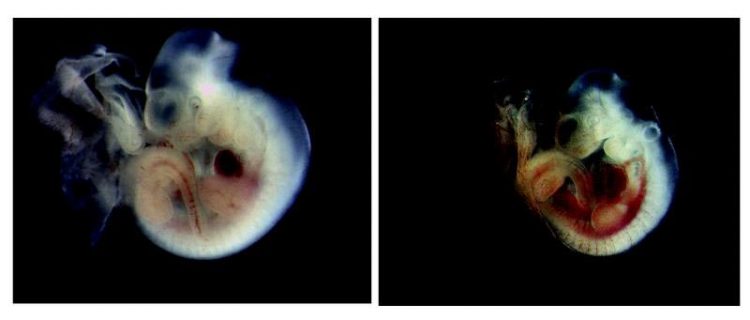Insights into a versatile molecular death switch

Pictures shows a wild type embryo on the left and an expressing inactive Caspase-8 (right). Copyright CECAD
he enzyme caspase-8 induces a molecular cell death programme called pyroptosis without involving its enzymatic activity, a new study by Hamid Kashkar published in Nature shows. In order to safeguard healthy and functioning tissues, cells utilize different cell death mechanisms to dispose of unwanted cells (e.g. infected or aged cells).
Apoptosis is a ‘cellular suicide programme’ that does not cause tissue injury and is induced by caspase-8. Necroptosis is another mode of regulated cell death which causes cellular damage and is normally engaged when caspase-8 is inhibited.
Pyroptosis describes an inflammatory mode of regulated cellular death process, which is normally activated in response to microbial pathogens and is central for mounting anti-microbial immunity. Hamid Kashkar and his team have now shown that caspase-8 not only controls apoptosis and necroptosis but pyroptosis as well. The study ‘Caspase-8 is the molecular switch for apoptosis, necroptosis and pyroptosis’ was published in Nature.
The research team studied the biological roles of caspase-8 in cell cultures and mice. Kashkar’s group showed that the enzymatic activity of caspase-8 is required to inhibit pyroptosis. ’We found out that the expression of inactive caspase-8 causes embryonic lethality and inflammatory tissue destruction. This could only be restored when necropto¬¬sis and pyroptosis were simultaneously blocked,’ Hamid Kashkar explains. The lack of caspase-8 enzymatic activity primarily causes necroptotic cell death. Interestingly, when necroptosis is blocked, the inactive caspase-8 serves as a protein scaffold for the formation of a signalling protein complex called inflammasome, which ultimately induces pyroptosis. ‘Microbial pathogens are heavily reliant on the fate of infected cells and have evolved a number of strategies to inhibit apoptosis and necroptosis,’ Hamid Kashkar adds.
The current study hypothesises that these strategies may have driven the counter-evolution of pyroptosis to secure cellular death as a host defence mechanism. The caspase-8-mediated switch between different modes of cell death adds a critical layer to the plasticity of cell death-induced immunity, which is increasingly involved in aging-associated disorders.
Contact:
Professor Hamid Kashkar
Institute for Medical Microbiology, Immunology and Hygiene
Cluster of Excellence CECAD
h.kashkar@uni-koeln.de
0221 478 84091
Press and Communications Team:
Peter Kohl
pkohl@uni-koeln.de
0221 478 84043
Publication:
Caspase-8 is the molecular switch for apoptosis, necroptosis and pyroptosis
Melanie Fritsch, Saskia D. Günther, Robin Schwarzer, Marie-Christine Albert, Fabian Schorn, J. Paul Werthenbach, Lars M. Schiffmann, Neil Stair, Hannah Stocks, Jens M. Seeger, Mohamed Lamkanfi, Martin Krönke, Manolis Pasparakis & Hamid Kashkar
Nature, DOI: 10.1038/s41586-019-1770-6
Media Contact
More Information:
http://www.uni-koeln.de/All latest news from the category: Life Sciences and Chemistry
Articles and reports from the Life Sciences and chemistry area deal with applied and basic research into modern biology, chemistry and human medicine.
Valuable information can be found on a range of life sciences fields including bacteriology, biochemistry, bionics, bioinformatics, biophysics, biotechnology, genetics, geobotany, human biology, marine biology, microbiology, molecular biology, cellular biology, zoology, bioinorganic chemistry, microchemistry and environmental chemistry.
Newest articles

First-of-its-kind study uses remote sensing to monitor plastic debris in rivers and lakes
Remote sensing creates a cost-effective solution to monitoring plastic pollution. A first-of-its-kind study from researchers at the University of Minnesota Twin Cities shows how remote sensing can help monitor and…

Laser-based artificial neuron mimics nerve cell functions at lightning speed
With a processing speed a billion times faster than nature, chip-based laser neuron could help advance AI tasks such as pattern recognition and sequence prediction. Researchers have developed a laser-based…

Optimising the processing of plastic waste
Just one look in the yellow bin reveals a colourful jumble of different types of plastic. However, the purer and more uniform plastic waste is, the easier it is to…



